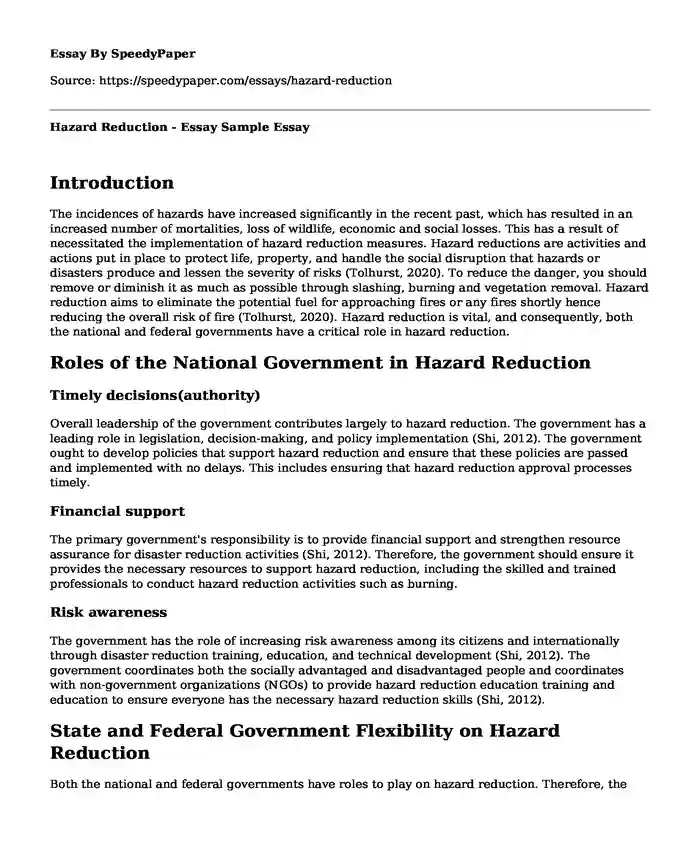
| Type of paper: | Essay |
| Categories: | Risk Economics Disaster Risk management Social issue |
| Pages: | 3 |
| Wordcount: | 636 words |
Introduction
The incidences of hazards have increased significantly in the recent past, which has resulted in an increased number of mortalities, loss of wildlife, economic and social losses. This has a result of necessitated the implementation of hazard reduction measures. Hazard reductions are activities and actions put in place to protect life, property, and handle the social disruption that hazards or disasters produce and lessen the severity of risks (Tolhurst, 2020). To reduce the danger, you should remove or diminish it as much as possible through slashing, burning and vegetation removal. Hazard reduction aims to eliminate the potential fuel for approaching fires or any fires shortly hence reducing the overall risk of fire (Tolhurst, 2020). Hazard reduction is vital, and consequently, both the national and federal governments have a critical role in hazard reduction.
Roles of the National Government in Hazard Reduction
Timely decisions(authority)
Overall leadership of the government contributes largely to hazard reduction. The government has a leading role in legislation, decision-making, and policy implementation (Shi, 2012). The government ought to develop policies that support hazard reduction and ensure that these policies are passed and implemented with no delays. This includes ensuring that hazard reduction approval processes timely.
Financial support
The primary government's responsibility is to provide financial support and strengthen resource assurance for disaster reduction activities (Shi, 2012). Therefore, the government should ensure it provides the necessary resources to support hazard reduction, including the skilled and trained professionals to conduct hazard reduction activities such as burning.
Risk awareness
The government has the role of increasing risk awareness among its citizens and internationally through disaster reduction training, education, and technical development (Shi, 2012). The government coordinates both the socially advantaged and disadvantaged people and coordinates with non-government organizations (NGOs) to provide hazard reduction education training and education to ensure everyone has the necessary hazard reduction skills (Shi, 2012).
State and Federal Government Flexibility on Hazard Reduction
Both the national and federal governments have roles to play on hazard reduction. Therefore, the two governments should blend well through cooperation to ensure that the hazard reduction policies and activities are well implemented and supported politically, economically, culturally, and socially.
The federal government ought to utilize the national government as a conduit to ease information exchange and hazard reduction planning at the regional levels (King, 2008). This is even more critical when the national government needs to consolidate information such as education and training across multiple federal states. Moreover, federal governments are better positioned to conduct hazard vulnerability in their local communities (King, 2008). By doing this, the local governments can then establish goals and policies of hazard reduction in partnership with the national government
The national government enhances the coordination and linking of regional disaster management both within and across the federal states (Shi, 2012). When collaborating and engaging with their local and regional partners, national governments are in an excellent position. To enhance and encourage the intra and interstate harmonization and consistency essential for effective hazard reduction policy integration and implementation (Shi, 2012). To decide the need for hazard reduction, efforts, and commitment from national and local governments are necessary. Goals on hazard reduction from the federal government should be integrated with those from local government.
Conclusion
The drift of increasing losses to hazards can be reversed. It can be achieved by integrating hazard reduction policy and practice, while lessons learned from the post hazard period can be applied to improve hazard reduction.
References
King, D. (2008, April 04). Reducing hazard vulnerability through local government engagement and action. Natural hazards, 47(3), 497-508. https://link.springer.com/article/10.1007/s11069-008-9235-5
Shi, P. (2012, November 21). On the role of government in integrated disaster risk governance—Based on practices in China. International Journal of Disaster Risk Science, 3(3), 139-146. https://link.springer.com/article/10.1007/s13753-012-0014-2
Tolhurst, K. (2020, February 19). The Burn Legacy: Why the Science on Hazard Reduction is Contested. The Conversation. https://theconversation.com/the-burn-legacy-why-the-science-on-hazard-reduction-is-contested-132083
Cite this page
Hazard Reduction - Essay Sample. (2023, Dec 15). Retrieved from https://speedypaper.net/essays/hazard-reduction
Request Removal
If you are the original author of this essay and no longer wish to have it published on the SpeedyPaper website, please click below to request its removal:
- Free Essay: Fake News as a Technology-Related Issue in Society
- Intellectual Migration Among Kazakhstan Millennials. Paper Example
- Essay Sample on The Hawaiian Case
- Essay Sample on Group Reflection
- Essay Sample on How Mcleod Should Handle Dilemma
- Aposematism in Action: Unveiling the Protective Role of Bright Colors in Dendrobatid Poison Frogs
- Beyond the Frame: Unraveling Sexual Representation in Cinema through Critical Analysis and Queer Theory
Popular categories




